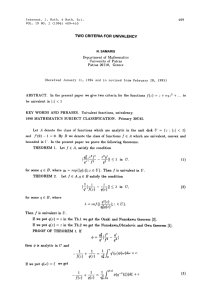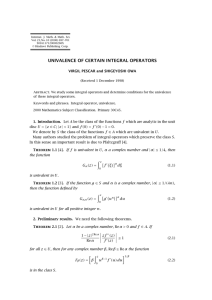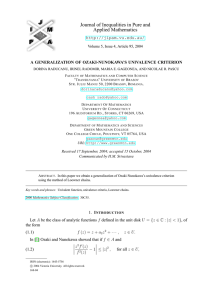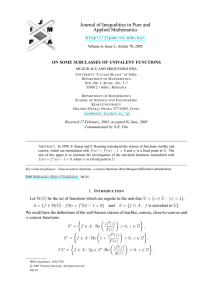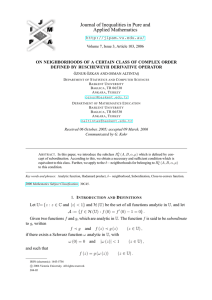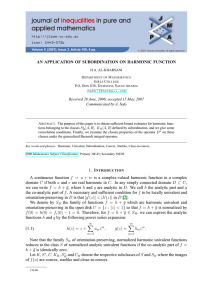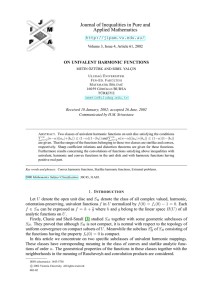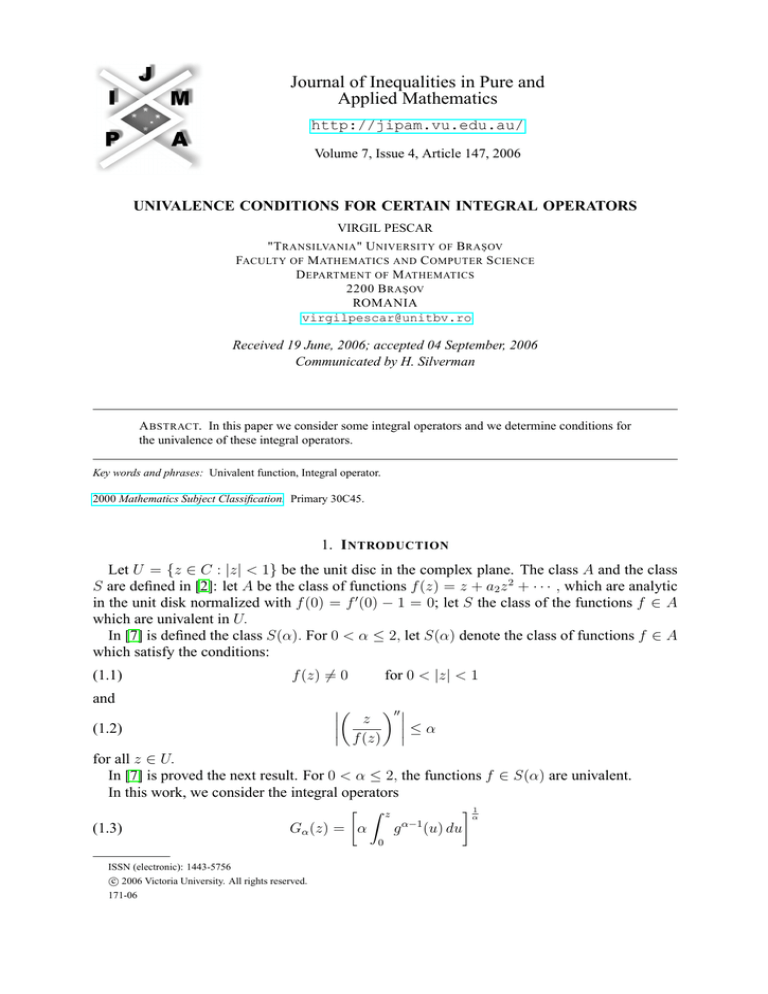
Journal of Inequalities in Pure and
Applied Mathematics
http://jipam.vu.edu.au/
Volume 7, Issue 4, Article 147, 2006
UNIVALENCE CONDITIONS FOR CERTAIN INTEGRAL OPERATORS
VIRGIL PESCAR
"T RANSILVANIA " U NIVERSITY OF B RA ŞOV
FACULTY OF M ATHEMATICS AND C OMPUTER S CIENCE
D EPARTMENT OF M ATHEMATICS
2200 B RA ŞOV
ROMANIA
virgilpescar@unitbv.ro
Received 19 June, 2006; accepted 04 September, 2006
Communicated by H. Silverman
A BSTRACT. In this paper we consider some integral operators and we determine conditions for
the univalence of these integral operators.
Key words and phrases: Univalent function, Integral operator.
2000 Mathematics Subject Classification. Primary 30C45.
1. I NTRODUCTION
Let U = {z ∈ C : |z| < 1} be the unit disc in the complex plane. The class A and the class
S are defined in [2]: let A be the class of functions f (z) = z + a2 z 2 + · · · , which are analytic
in the unit disk normalized with f (0) = f 0 (0) − 1 = 0; let S the class of the functions f ∈ A
which are univalent in U.
In [7] is defined the class S(α). For 0 < α ≤ 2, let S(α) denote the class of functions f ∈ A
which satisfy the conditions:
(1.1)
f (z) 6= 0
for 0 < |z| < 1
and
(1.2)
00 z
f (z) ≤ α
for all z ∈ U.
In [7] is proved the next result. For 0 < α ≤ 2, the functions f ∈ S(α) are univalent.
In this work, we consider the integral operators
Z z
α1
α−1
(1.3)
Gα (z) = α
g (u) du
0
ISSN (electronic): 1443-5756
c 2006 Victoria University. All rights reserved.
171-06
2
V IRGIL P ESCAR
and
Z
Hα, γ (z) = α
(1.4)
z
u
α−1
0
h(u)
u
α1
γ
du
for g(z) ∈ S, h(z) ∈ S and for some α, γ ∈ C.
Kim - Merkes [1] studied the integral operator
γ
Z z
h(u)
du
(1.5)
Fγ (z) =
u
0
and obtained the following result
Theorem 1.1. If the function h(z) belongs to the class S, then for any complex number γ, |γ| ≤
1
, the function Fγ (z) defined by (1.5) is in the class S.
4
2. P RELIMINARY R ESULTS
In order to prove our main results we will use the lemma due to N.N. Pascu [4] presented in
this section.
Lemma 2.1. Let the function f ∈ A and α a complex number, Re α > 0. If
1 − |z|2 Re α zf 00 (z) (2.1)
f 0 (z) ≤ 1,
Re α
for all z ∈ U , then for all complex numbers β, Re β ≥ Re α the function
Z z
β1
β−1 0
(2.2)
Fβ (z) = β
u
f (u)du
0
is regular and univalent in U .
3. M AIN R ESULTS
Theorem 3.1. Let α be a complex number, Re α ≥ 0 and the function g ∈ S, g(z) = z +
a2 z 2 + · · · . If
Re α
(j1 )
|α − 1| ≤
for Re α ∈ (0, 1)
4
or
1
(j2 )
|α − 1| ≤
for Re α ∈ [1, ∞),
4
then the function
Z z
α1
α−1
(3.1)
Gα (z) = α
g (u) du
0
is in the class S.
Proof. From (3.1) we have
(3.2)
" Z
Gα (z) = α
0
z
uα−1
g(u)
u
# α1
α−1
du
.
6= 0 for all z ∈ U. We can choose the
The function g(z) is regular and univalent, hence g(z)
z
h iα−1
g(z)
regular branch of the function z
to be equal to 1 at the origin.
J. Inequal. Pure and Appl. Math., 7(4) Art. 147, 2006
http://jipam.vu.edu.au/
U NIVALENCE C ONDITIONS FOR C ERTAIN I NTEGRAL O PERATORS
3
Let us consider the regular function in U , given by
α−1
Z z
g(u)
(3.3)
p(z) =
du.
u
0
Because g ∈ S, we obtain
0 z g (z) 1 + |z|
g(z) ≤ 1 − |z|
(3.4)
for all z ∈ U.
We have
(3.5)
1 − |z|2 Re α
Re α
00 z p (z) 1 − |z|2 Re α z g 0 (z)
=
−
1
p0 (z) g(z)
Re α
zg 0 (z) 1 − |z|2 Re α
≤
|α − 1| +1 .
Re α
g(z) From (3.5) and (3.4) we obtain
(3.6)
2
1 − |z|2 Re α z p00 (z) 1 − |z|2 Re α
≤
|α
−
1|
.
p0 (z) Re α
Re α
1 − |z|
Now, we consider the cases
i1 ) 0 < Re α < 1.
The function
s : (0, 1) → <, s(x) = 1 − a2x (0 < a < 1)
is a increasing function and for a = |z|, z ∈ U, we obtain
1 − |z|2 Re α ≤ 1 − |z|2
(3.7)
for all z ∈ U.
From (3.6) and (3.7), we have
(3.8)
1 − |z|2 Re α zp00 (z) 4 |α − 1|
p0 (z) ≤ Re α
Re α
for all z ∈ U.
Using the condition (j1 ) and (3.8) we get
1 − |z|2 Re α zp00 (z) p0 (z) ≤ 1
Re α
(3.9)
for all z ∈ U.
i2 ) Re α ≥ 1.
We observe that the function
1 − a2x
(0 < a < 1)
x
is a decreasing function, and that, if we take a = |z|, z ∈ U, then
q : [1, ∞) → <,
q(x) =
1 − |z|2 Re α
≤ 1 − |z|2
Re α
(3.10)
for all z ∈ U.
From (3.6) and (3.10) we obtain
(3.11)
1 − |z|2 Re α
Re α
J. Inequal. Pure and Appl. Math., 7(4) Art. 147, 2006
00 zp (z) p0 (z) ≤ 4 |α − 1|.
http://jipam.vu.edu.au/
4
V IRGIL P ESCAR
From (3.11) and (j2 ), we have
1 − |z|2 Re α
Re α
(3.12)
00 zp (z) p0 (z) ≤ 1
for all z ∈ U.
α−1
Using (3.9), (3.12) and because p0 (z) = g(z)
, from Lemma 2.1 for α = β it results that
z
the function Gα (z) is in the class S.
4 5
Theorem 3.2. If α is a real number, α ∈ 5 , 4 and the function g ∈ S(α), then the function
Z z
α1
α−1
(3.13)
Gα (z) = α
g (u) du
0
is in the class S.
Proof. If g ∈ S(α), then g ∈ S and by Theorem 3.1 for α ∈
Gα (z) in the class S.
4
5
,
5
4
, we obtain the function
Theorem 3.3. Let α, γ be a complex numbers and the function h ∈ S, h(z) = z + a2 z 2 + · · · .
If
Re α
(p1 )
|γ| ≤
for Re α ∈ (0, 1)
4
or
1
for Re α ∈ [1, ∞)
(p2 )
|γ| ≤
4
then the function
Z z
γ α1
h(u)
α−1
(3.14)
Hα, γ (z) = α
u
du
u
0
is regular and univalent in U.
Proof. Let us consider the regular function in U, defined by
γ
Z z
h(u)
(3.15)
f (z) =
du.
u
0
For the function h ∈ S, we obtain
0 z h (z) 1 + |z|
(3.16)
h(z) ≤ 1 − |z|
for all z ∈ U.
We obtain
0 zh (z) 1 − |z|2 Re α z f 00 (z) 1 − |z|2 Re α
+1 .
(3.17)
|γ| f 0 (z) ≤
Re α
Re α
h(z) From (3.17) and (3.16), we have
(3.18)
1 − |z|2 Re α z f 00 (z) 1 − |z|2 Re α
2
≤
|γ|
f 0 (z) Re α
Re α
1 − |z|
We consider the cases
j1 ) 0 < Re α < 1.
In this case we obtain
(3.19)
1 − |z|2 Re α ≤ 1 − |z|2
J. Inequal. Pure and Appl. Math., 7(4) Art. 147, 2006
http://jipam.vu.edu.au/
U NIVALENCE C ONDITIONS FOR C ERTAIN I NTEGRAL O PERATORS
5
for all z ∈ U.
From (3.18) and (3.19), we get
(3.20)
4 |γ|
1 − |z|2 Re α zf 00 (z) ≤
0
Re α
f (z)
Re α
for all z ∈ U.
By (3.20) and (p1 ) we have
1 − |z|2 Re α
Re α
(3.21)
00 zf (z) f 0 (z) ≤ 1
for all z ∈ U.
j2 ) Re α ≥ 1.
For this case we obtain
1 − |z|2 Re α
≤ 1 − |z|2
Re α
(3.22)
for all z ∈ U.
From (3.18) and (3.22) we have
(3.23)
1 − |z|2 Re α
Re α
00 zf (z) f 0 (z) ≤ 4 |γ|.
From (3.23) and (p2 ), we get
(3.24)
1 − |z|2 Re α
Re α
00 zf (z) f 0 (z) ≤ 1
for all z ∈ U.
γ
From (3.21), (3.24) and because f 0 (z) = h(z)
, from Lemma 2.1 for α = β it results that
z
the function Hα,γ (z) is in the class S.
Remark 3.4. For α = 1, from Theorem 3.3 we obtain Theorem 1.1, the result due to KimMerkes.
Theorem 3.5. Let γ be a complex number and the function h ∈ S(a).
If
α
(3.25)
|γ| ≤
for α ∈ (0, 1)
4
or
1
(3.26)
|γ| ≤
for α ∈ [1, 2]
4
then the function Hα, γ (z) defined by (3.14) is in the class S.
Proof. Because h(z) ∈ S(α), 0 < α ≤ 2, then h(z) ∈ S and by Theorem 3.3 the function
Hα, γ (z) belongs to the class S.
R EFERENCES
[1] Y.J. KIM AND E.P. MERKES, On an integral of powers of a spirallike function, Kyungpook Math.
J., 12(2) (1972), 249–253.
[2] P.T. MOCANU, T. BULBOACĂ AND G.St. SĂLĂGEAN, The Geometric Theory of Univalent Functions, Cluj, 1999.
[3] Z. NEHARI, Conformal Mapping, Mc Graw-Hill Book Comp., New York, 1952 (Dover. Publ. Inc.,
1975).
J. Inequal. Pure and Appl. Math., 7(4) Art. 147, 2006
http://jipam.vu.edu.au/
6
V IRGIL P ESCAR
[4] N.N. PASCU, An improvement of Becker’s univalence criterion, Proceedings of the Commemorative
Session Simion Stoilov, Braşov, (1987), 43–48.
[5] V. PESCAR, New univalence criteria, "Transilvania" University of Braşov, Braşov, 2002.
[6] C. POMMERENKE, Univalent Functions, Vanderhoeck Ruprecht, Gőttingen, 1975.
[7] D. YANG AND J. LIU, On a class of univalent functions, IJMMS, 22(3) (1999), 605–610.
J. Inequal. Pure and Appl. Math., 7(4) Art. 147, 2006
http://jipam.vu.edu.au/

